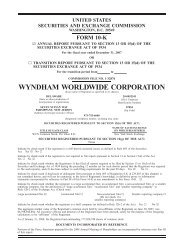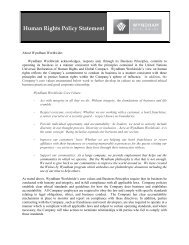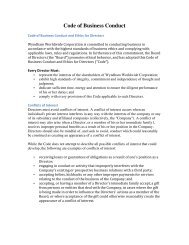WYNDHAM WORLDWIDE CORPORATION
WYNDHAM WORLDWIDE CORPORATION
WYNDHAM WORLDWIDE CORPORATION
Create successful ePaper yourself
Turn your PDF publications into a flip-book with our unique Google optimized e-Paper software.
In addition, we have vacation ownership contract receivables that have not been securitized through bankruptcyremote<br />
SPEs. Such gross receivables were $641 million and $860 million as of December 31, 2010 and 2009,<br />
respectively. A summary of total vacation ownership receivables and other securitized assets, net of securitized<br />
liabilities and the allowance for loan losses, is as follows:<br />
December 31,<br />
2010<br />
December 31,<br />
2009<br />
SPE assets in excess of SPE liabilities $ 1,193 $ 1,222<br />
Non-securitized contract receivables 641 598<br />
Secured contract receivables (*)<br />
— 262<br />
Allowance for loan losses (362) (370)<br />
Total, net $ 1,472 $ 1,712<br />
(*)<br />
As of December 31, 2009, such receivables collateralized our secured, revolving foreign credit facility, which was paid down and terminated during<br />
March 2010.<br />
Covenants<br />
The revolving credit facility is subject to covenants including the maintenance of specific financial ratios. The<br />
financial ratio covenants consist of a minimum consolidated interest coverage ratio of at least 3.0 to 1.0 as of the<br />
measurement date and a maximum consolidated leverage ratio not to exceed 3.75 to 1.0 on the measurement date.<br />
The consolidated interest coverage ratio is calculated by dividing consolidated EBITDA (as defined in the credit<br />
agreement) by consolidated interest expense (as defined in the credit agreement), both as measured on a trailing<br />
12 month basis preceding the measurement date. As of December 31, 2010, our consolidated interest coverage ratio<br />
was 8.0 times. Consolidated interest expense excludes, among other things, interest expense on any securitization<br />
indebtedness (as defined in the credit agreement). The consolidated leverage ratio is calculated by dividing<br />
consolidated total indebtedness (as defined in the credit agreement and which excludes, among other things,<br />
securitization indebtedness) as of the measurement date by consolidated EBITDA as measured on a trailing 12 month<br />
basis preceding the measurement date. As of December 31, 2010, our consolidated leverage ratio was 2.0 times.<br />
Covenants in this credit facility also include limitations on indebtedness of material subsidiaries; liens; mergers,<br />
consolidations, liquidations and dissolutions; sale of all or substantially all of our assets; and sale and leaseback<br />
transactions. Events of default in this credit facility include failure to pay interest, principal and fees when due;<br />
breach of a covenant or warranty; acceleration of or failure to pay other debt in excess of $50 million (excluding<br />
securitization indebtedness); insolvency matters; and a change of control.<br />
The 6.00% senior unsecured notes, 9.875% senior unsecured notes, 7.375% senior unsecured notes and<br />
5.75% senior unsecured notes contain various covenants including limitations on liens, limitations on potential sale<br />
and leaseback transactions and change of control restrictions. In addition, there are limitations on mergers,<br />
consolidations and potential sale of all or substantially all of our assets. Events of default in the notes include failure<br />
to pay interest and principal when due, breach of a covenant or warranty, acceleration of other debt in excess of<br />
$50 million and insolvency matters. The convertible notes do not contain affirmative or negative covenants, however,<br />
the limitations on mergers, consolidations and potential sale of all or substantially all of our assets and the events of<br />
default for our senior unsecured notes are applicable to such notes. Holders of the convertible notes have the right to<br />
require us to repurchase the convertible notes at 100% of principal plus accrued and unpaid interest in the event of a<br />
fundamental change, defined to include, among other things, a change of control, certain recapitalizations and if our<br />
common stock is no longer listed on a national securities exchange.<br />
As of December 31, 2010, we were in compliance with all of the financial covenants described above.<br />
Each of our non-recourse, securitized term notes and the bank conduit facility contain various triggers relating<br />
to the performance of the applicable loan pools. If the vacation ownership contract receivables pool that<br />
collateralizes one of our securitization notes fails to perform within the parameters established by the contractual<br />
triggers (such as higher default or delinquency rates), there are provisions pursuant to which the cash flows for that<br />
pool will be maintained in the securitization as extra collateral for the note holders or applied to accelerate the<br />
repayment of outstanding principal to the noteholders. As of December 31, 2010, all of our securitized loan pools<br />
were in compliance with applicable contractual triggers.<br />
LIQUIDITY RISK<br />
Our vacation ownership business finances certain of its receivables through (i) an asset-backed bank conduit<br />
facility and (ii) periodically accessing the capital markets by issuing asset-backed securities. None of the currently<br />
outstanding asset-backed securities contains any recourse provisions to us other than interest rate risk related to swap<br />
counterparties (solely to the extent that the amount outstanding on our notes differs from the forecasted amortization<br />
schedule at the time of issuance).<br />
64







